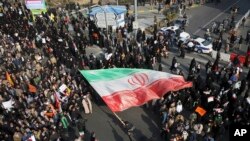Iranian officials said Tuesday at least five members of the country’s security forces were killed and more than 300 people arrested during overnight clashes between Sufi protesters and police in the capital, Tehran.
Monday’s protests in front of a police station in northern Tehran were held by the Sufi group Gonabadi, locally known as Gonabadi dervishes, who demanded the release of their arrested members and the removal of security checkpoints around the house of their 90-year-old leader, Noor Ali Tabandeh.
The rally turned violent after the Iranian police tried to disperse the crowd of protestors marching towards Tabandeh’s home.
The official news agency IRNA on Tuesday quoted police spokesperson Saeed Montazer Almehdi as confirming the death of five security officers.
Almehdi told the semi-official ISNA news that members of the Islamic Revolutionary Guard’s Basij group were among those killed.
"Two of our dear Basiji members were martyred by the superstitious cult," he told the agency, adding that 30 police officers on the scene were also injured.
Sufism is a mystical strain of Islam characterized by an inward search for God and the rejection of materialism.
There are no official statistics on the size of the Sufi population in Iran, but some reports estimate their numbers to be between two and five million people. The group has followers in other countries as well including Afghanistan, Pakistan, Iraq, Turkey and parts of India.
In Iran, the group is subject to continued scrutiny and harassment because the government views them as heretics.
Violent Clashes
Monday’s event is not the first time the religious minority has clashed with the government over its rights and freedom. On two separate occasions in 2006 and 2007, a government decision to close a Sufi shrine led to rallies by its adherents and subsequent government crackdowns.
Monday’s clashes mark the first time the group’s protestors caused causalities to the Iranian security forces.
Iranian social media circulated video allegedly showing the moment when the cars ploughed into a group of policemen and the security forces clashing with black-clad protesters.
VOA could not independently verify the authenticity of the videos.
Police spokesman Almehdi told local media more than 300 Suffi protesters were arrested, including the two drivers of the vehicles that mowed down the riot police.
Causalities have been reported among the protestors as well. Majzooban Noor, a website managed by members of Gonabadi Sufis, said at least one protester was killed and several others injured after the police live ammunition to disperse the crowd.
The website claimed the number of arrested is more than the 300 reported by the Iranian government media outlets, adding that several members of the group were detained at the airport before they could flee the country.
Religious minorities
The Shiite-dominant Islamic Republic of Iran has often been criticized for its harsh treatment of the country’s minorities.
A U.N. Special Rapporteur on Human Rights in Iran last year expressed concerns over the targeting of Sufi followers, saying they "continue to face arbitrary arrest, harassment, and detention and are often accused of national security crimes."
A 2017 report by the U.S. Commission on International Religious Freedom said the Suffi members are often targeted on the basis of non-conformity to the state’s official interpretation of Islam and their beliefs are regularly demonized on the Iranian state television.
It said members of the Gonabadi group continue to face abuses, including attacks on their prayer centers, destruction of community cemeteries, harassment, arrests, and physical assaults on their leaders.
According to Hemin Sayidi, a London-based Iranian expert, the Gonabadi Sufi clashes with the police could be considered a continuation of anti-government demonstrations that took place in more than 80 towns that resulted in 25 deaths and thousands of arrests last December.
"These protest movements, be it in the name of poverty or religious oppression, indicate that people are weary of the current oppressive regime," Sayidi told VOA.
VOA’s Jani Diylan contributed to this report.










